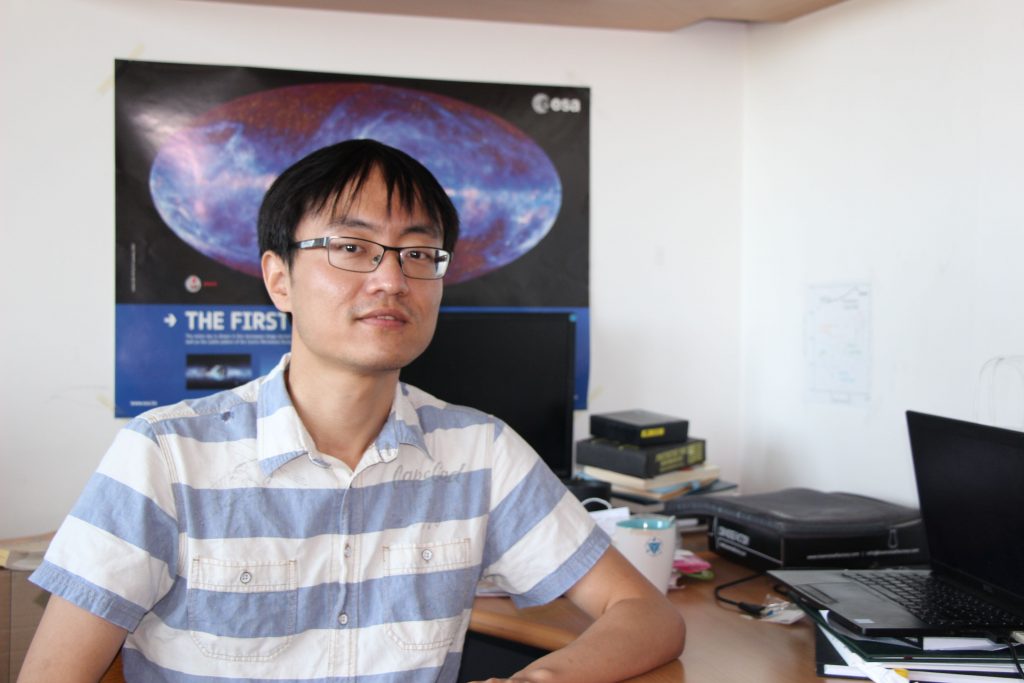Kinetic Inductance Detectors : findind light, one photon at the time
For the past two years, Jie Hu has been working as a post-doc researcher at the AstroParticule & Cosmologie laboratory on a new generation of Kinetic Inductance Detectors, a promising technology for highly sensitive astrophysics instruments, whose development received funding from the LabEx UnivEarthS.

How to observe what is barely visible? This issue is at the core of astronomy and instrumental astrophysics. In those fields, any tiny or faint source of light (and its variation) originating from infinitely far astrophysical phenomena, could tell us more about our Universe. Therefore, every photon counts.
But not only is it essential to catch as much light as possible (using very big telescope mirrors), it is also important to look at how photons are recorded by the detector. The most efficient detector should ideally be able to gather all available information for each and every single captured photon. One promising device could actually achieve this exploit: the Kinetic Inductance Detector (KID).
KID technology offers several advantages: it is fast, has extremely low noise, is simple to build and can be easily implemented in large arrays. This is why KIDs are developed for numerous applications, ranging from the far-infrared to X-rays astronomy. This is also why KIDs developments have been one of the projects backed by the LabEx UnivEarthS, by, amongst others, the funding of a postdoc position.
Jie Hu is an instrumental astrophysicist in postdoc at the AstroParticule & Cosmologie laboratory (APC, Université de Paris / CNRS / CEA) since 2018. He received his PhD degree in 2017 at the Purple Mountain Observatory in Nanjing, the oldest working observatory in China.
For the past two years, Jie Hu has been working, with his colleagues from APC and the Galaxies, Etoiles, Physique, Instrumentation laboratory (GEPI, Observatoire de Paris / CNRS), on the development of the new generation of KIDs (NGKIDs) detection chain.
Two kinds of detectors are currently on the work: the first one, detecting photons on the microwave range, is built to measure polarisation of the Cosmic Microwave Background, and a second one, in the near-infrared and optical bands, to detect faint galaxies. But how does a KID work?

“KID is essentially a superconducting resonator on a circuit chip, Jie Hu explains. When the superconducting material absorbs a photon, this shifts the resonating frequency of the circuit. If we are able to measure this frequency shift, we can not only rapidly detect a single-photon event, but also measure the energy of the inciding photon on the chip. That’s pretty neat.”
Superconductors mean extremely low temperature. For the new kind of KIDs in the near-infrared and optical bands that the APC and GEPI labs are developing, aluminium and gold were the chosen materials. This Al/Au KID needs to be cooled down to temperature below 1K in order for the superconducting properties of aluminium and gold to occur. The cryostat used at the APC laboratory for the KIDs testing and characterisation can actually reach 50mK.
As for now, this novel KID design is not yet successful at detecting a single-photon event. “One way to quantify the efficiency of our KIDs is to measure its energy resolution, Jie Hu specifies. It was to be over 10 in order to detect a single photon. Right now, the best energy resolution we measured for our KIDs is around 9. So we are close, but there is still work to be done.”
A work that has been delayed by the on-going Covid-19 pandemic. “It was difficult to work from home, because we had no equipment, and no measurements were possible, the researcher tells. Our colleagues at the GEPI couldn’t build new KIDs chips, and we at the APC couldn’t work on the detection bench characterisation. I had to focus on tasks that I could do from home, like designing the chip or data analysis.”Now that they are back in the lab, the team expects to deliver a functional optical and near-infrared KID for the next year.
In addition to his research activities, Jie Hu is also working on building on an active collaboration between the APC/GEPI team and the Energetic Cosmos Laboratory (ECL, Nazarbayev University) in Kazakhstan for the development of KIDs technology. The young researcher has actually been there twice for his work.
“I really like my work here at APC. I have a lot of freedom on how to conduct my research and how I manage my time. Also I have made good friends among my colleagues and supervisor.” When he is not in the lab, Jie Hu likes to run and to visit Paris museums. “I am really enjoying the city, particularly right now after staying at home for so long”.
